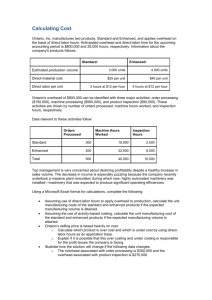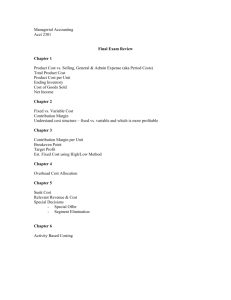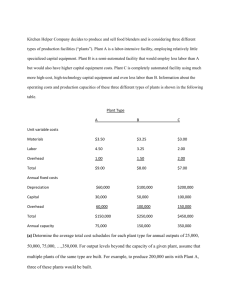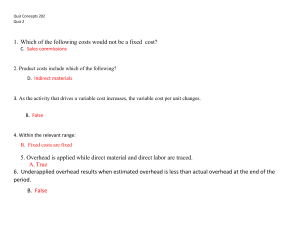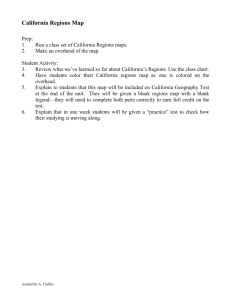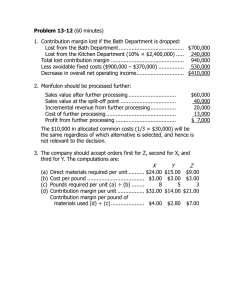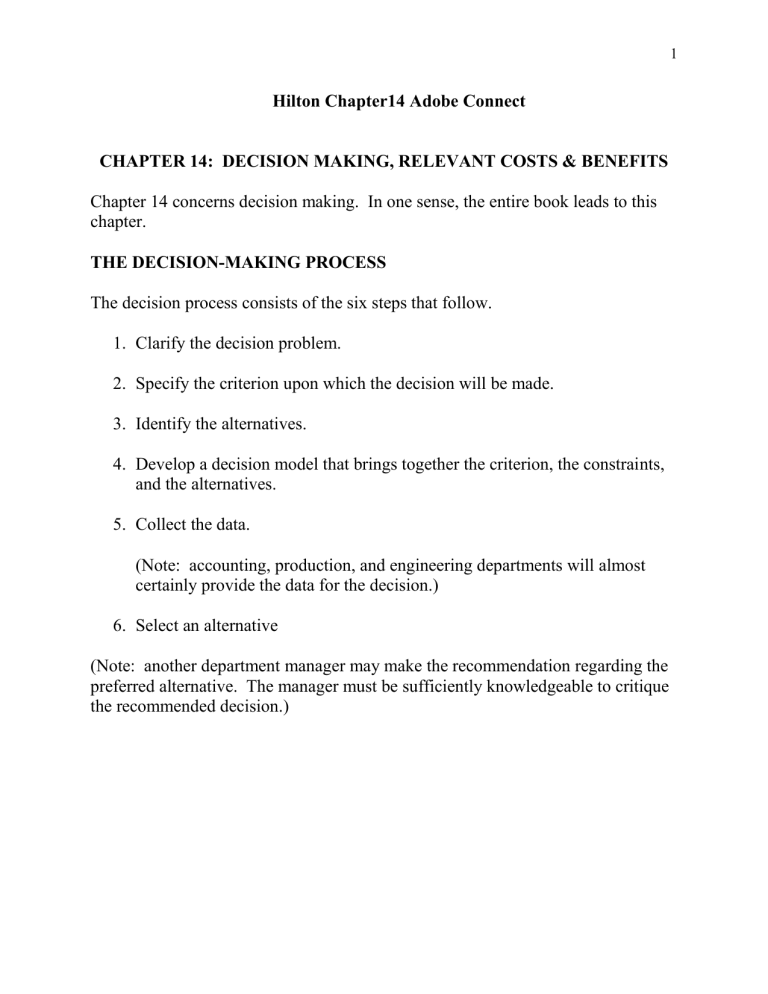
1 Hilton Chapter14 Adobe Connect CHAPTER 14: DECISION MAKING, RELEVANT COSTS & BENEFITS Chapter 14 concerns decision making. In one sense, the entire book leads to this chapter. THE DECISION-MAKING PROCESS The decision process consists of the six steps that follow. 1. Clarify the decision problem. 2. Specify the criterion upon which the decision will be made. 3. Identify the alternatives. 4. Develop a decision model that brings together the criterion, the constraints, and the alternatives. 5. Collect the data. (Note: accounting, production, and engineering departments will almost certainly provide the data for the decision.) 6. Select an alternative (Note: another department manager may make the recommendation regarding the preferred alternative. The manager must be sufficiently knowledgeable to critique the recommended decision.) 2 RELEVANT INFORMATION The information gathered should be relevant to the opportunity or problem at hand. Relevant information involves costs and benefits that 1. Differ among the alternatives being considered 2. Are future oriented. Both guidelines must be met. This concept is an important, key takeaway. The costs relevant for decision making are those that are future costs (and benefits) and that differ between (or among) alternatives. Sunk costs are past costs that have already been incurred. Such costs are irrelevant in decision making because the amounts cannot be changed by any of the alternatives under review. A differential cost is the net difference in cost between two alternatives. An opportunity cost is the cost of a forgone alternative. Companies must frequently pass up profitable (beneficial) projects. The profit (benefit) forgone becomes an opportunity cost to the firm, and such costs are relevant in the decision-making 3 SPECIAL DECISION SITUATIONS Note: The decisions in this chapter are primarily short-term in nature. The text covers four common decision making situations that confront mangers. 1. 2. 3. 4. Accept a Special Order Make or Buy Add or Drop a Product, Service, or Department Joint Products: Sell or Process Further 4 SPECIAL ORDERS In this situation, a manager considers an order (often a one-time order) at a special price. Key issues to evaluate include: Cost behavior: Unless told otherwise, students should assume that total fixed costs remain fixed and only total variable costs change. Qualitative considerations: These include, among other things, The reaction of present customers should they hear about the special price, An organization's available capacity (a key decision variable) Regulations that guard against price discrimination. Organization with Sufficient Capacity Opportunity costs not an issue Assume that unused capacity exists to meet the special order unless otherwise indicated Generally, only the variable costs with producing the special order Organization at Capacity The opportunity cost of the lost contribution margin from regular, higherpriced sales must be factored into the decision. Special Order Problem S'Round Sound, Inc. (SRS) reported the following results from the sale of 24,000 units of IT-54: Sales Variable manufacturing costs Fixed manufacturing costs Variable selling costs Fixed administrative costs $528,000 288,000 120,000 52,800 35,200 Rhythm Company has offered to purchase 3,000 IT-54s at $16 each. Sound has available capacity, and the president is in favor of accepting the order. She feels it would be profitable because no variable selling costs will be incurred. The plant manager is opposed because the "full cost" of production is $17 ($408,000 / 24,000 = 17). Ignoring qualitative consideration, if the special order is accepted, how much will SRS’s net income change? Recast as contribution margin Current $528,000 (1) 288,000 52,800 187,200 35.45% Fixed manufacturing costs 120,000 Fixed administrative costs 35,200 Net income 32,000 (1) $288,000 / 24,000 units = $12 per unit (2) 3,000 @ $16 = $48,000 (3) 3,000 x $12 = 36,000 Sales Variable manufacturing costs Variable selling costs Contribution margin Sp. Ord (2)48,000 36,000 0 12,000 New Income 12,000 44,000 5 MAKE OR BUY (PRODUCE IN-HOUSE OR OUTSOURCE) This situation requires careful consideration of fixed costs. The total cost per unit of a product or service includes a unitized portion of fixed cost, a cost that may continue even if the item or service is purchased elsewhere at a lower price. Example. Attached is a management report. Is the management report correct? If not, please prepare your own financial analysis and make a recommendation based only on the financial information. Confirming Pages Chapter 14 629 Decision Making: Relevant Costs and Benefits devoted to producing which product? (Assume that the excess capacity will be used for a single product line.) 2. If Carpenter’s Mate has excess machine capacity but a limited amount of labor time, the excess production capacity should be devoted to producing which product or products? (CMA, adapted) Casting Technology Resources (CTR) has purchased 10,000 pumps annually from Kobec, Inc. Because the price keeps increasing and reached $68.00 per unit last year, CTR’s management has asked for an estimate of the cost of manufacturing the pump in CTR’s facilities. CTR makes stampings and castings and has little experience with products requiring assembly. The engineering, manufacturing, and accounting departments have prepared a report for management that includes the following estimate for an assembly run of 10,000 pumps. Additional production employees would be hired to manufacture the pumps but no additional equipment, space, or supervision would be needed. The report states that total costs for 10,000 units are estimated at $957,000, or $95.70 per unit. The current purchase price is $68.00 per unit, so the report recommends continued purchase of the product. ■ Problem 14–49 Make or Buy (LO 4, 5) Components (outside purchases) ....................................................................................................................... $120,000 Assembly labor* ................................................................................................................................................ 300,000 Manufacturing overhead† ................................................................................................................................... 450,000 General and administrative overhead‡ ................................................................................................................. 87,000 Total costs .................................................................................................................................................... $957,000 *Assembly labor consists of hourly production workers. † Manufacturing overhead is applied to products on a direct-labor-dollar basis. Variable-overhead costs vary closely with direct-labor dollars. Fixed overhead ....................................................................................... Variable overhead ................................................................................... 50% of direct-labor dollars 100% of direct-labor dollars Manufacturing-overhead rate .................................................................. 150% of direct-labor dollars ‡ General and administrative overhead is applied at 10 percent of the total cost of material (or components), assembly labor, and manufacturing overhead. Was the analysis prepared by Casting Technology Resources’ engineering, manufacturing, and accounting departments and their recommendation to continue purchasing the pumps correct? Explain your answer and include any supporting calculations you consider necessary. Required: (CMA, adapted) The Midwest Division of the Paibec Corporation manufactures subassemblies that are used in the corporation’s final products. Lynn Hardt of Midwest’s Profit Planning Department has been assigned the task of determining whether a component, MTR–2000, should continue to be manufactured by Midwest or purchased from Marley Company, an outside supplier. MTR–2000 is part of a subassembly manufactured by Midwest. Marley has submitted a bid to manufacture and supply the 32,000 units of MTR–2000 that Paibec will need for 20x1 at a unit price of $17.30. Marley has assured Paibec that the units will be delivered according to Paibec’s production specifications and needs. While the contract price of $17.30 is only applicable in 20x1, Marley is interested in entering into a long-term arrangement beyond 20x1. Hardt has gathered the following information regarding Midwest’s cost to manufacture MTR–2000 in 20x0. These annual costs will be incurred to manufacture 30,000 units. ■ Problem 14–50 Outsourcing Decision; Relevant Costs; Ethics (LO 3, 4, 5) 1(a). Savings if purchased from Marley: $(15,440) Direct material ................................................................................... $195,000 Direct labor ........................................................................................ 120,000 Factory space rental ........................................................................... 84,000 Equipment leasing costs ..................................................................... 36,000 Other manufacturing overhead ............................................................ 225,000 Total manufacturing costs ................................................................... $660,000 hiL10912_ch14_590-641.indd 629 7/23/10 10:04 PM 12 INSOURCE VS OUTSOURCE The analysis prepared by the engineering, manufacturing, and accounting departments of CTR was not correct. However, their recommendation was correct, provided that potential labor-cost improvements are ignored. An incremental cost analysis similar to the following table should have been prepared to determine whether the pump should be purchased or manufactured. In the following analysis, fixed factory overhead costs and general and administrative overhead costs have not been included because they are not relevant; these costs would not increase, because no additional equipment, space, or supervision would be required if the pumps were manufactured. Therefore, if potential labor cost improvements are ignored, CTR should purchase the pumps because the purchase price of $68.00 is less than the $72.00 relevant cost to manufacture. Incremental cost analysis: Purchased components ................................................... Assembly labor ................................................................ Variable manufacturing overhead ................................ Total relevant cost ........................................................ Cost of 10,000 Unit Assembly Run $120,000 300,000 300,000 $720,000 Per Unit $12.00 30.00 30.00 $72.00 6 ADD OR DROP A SERVICE, PRODUCT, OR DEPARTMENT The key is the proper handling of fixed costs and determination if such amounts are avoidable or unavoidable. The manager should isolate costs that will disappear with that line. In many cases, fixed costs are not avoidable, particularly allocated common costs. The contribution margin lost from the activity to be dropped must also be considered. Attached is E14-31. Confirming Pages Chapter 14 Exercises All applicable Exercises are available with McGraw-Hill’s Connect Accounting ®. Choose an organization and a particular decision situation. Then give examples, using that decision context, of each step illustrated in Exhibit 14–1. Day Street Deli’s owner is disturbed by the poor profit performance of his ice cream counter. He has prepared the following profit analysis for the year just ended. Sales .................................................................................................................................. Less: Cost of food ............................................................................................................... Gross profit ......................................................................................................................... Less: Operating expenses: Wages of counter personnel ............................................................................................ Paper products (e.g., napkins) ......................................................................................... Utilities (allocated) ........................................................................................................... Depreciation of counter equipment and furnishings ........................................................... Depreciation of building (allocated) ................................................................................... Deli manager’s salary (allocated) ...................................................................................... Total ............................................................................................................................... Loss on ice cream counter ................................................................................................... ■ Exercise 14–29 Steps in Decision-Making Process (LO 14-1) ■ Exercise 14–30 Irrelevant Future Costs and Benefits (LO 14-3, 14-4) Redo Exhibit 14–4 without the irrelevant data. Required: 619 Decision Making: Relevant Costs and Benefits ■ Exercise 14–31 Drop Product Line (LO 14-4, 14-5) $67,500 30,000 $37,500 $18,000 6,000 4,350 3,750 6,000 4,500 42,600 $ (5,100) Criticize and correct the owner’s analysis. Toon Town Toy Company is considering the elimination of its Packaging Department. Management has received an offer from an outside firm to supply all Toon Town’s packaging needs. To help her in making the decision, Toon Town’s president has asked the controller for an analysis of the cost of running Toon Town’s Packaging Department. Included in that analysis is $11,100 of rent, which represents the Packaging Department’s allocation of the rent on Toon Town’s factory building. If the Packaging Department is eliminated, the space it used will be converted to storage space. Currently Toon Town rents storage space in a nearby warehouse for $13,000 per year. The warehouse rental would no longer be necessary if the Packaging Department were eliminated. ■ Exercise 14–32 Closing a Department (LO 14-4, 14-5) Required: 1. Discuss each of the figures given in the exercise with regard to its relevance in the departmentclosing decision. 2. What type of cost is the $13,000 warehouse rental, from the viewpoint of the costs of the Packaging Department? If Toon Town Toy Company closes its Packaging Department, the department manager will be appointed manager of the Cutting Department. The Packaging Department manager makes $51,000 per year. To hire a new Cutting Department manager will cost Toon Town $66,000 per year. Required: Discuss the relevance of each of these salary figures to the department-closing decision. College Town Pizza’s owner bought his current pizza oven two years ago for $10,500, and it has one more year of life remaining. He is using straight-line depreciation for the oven. He could purchase a new oven for $2,200, but it would last only one year. The owner figures the new oven would save him $3,000 in annual operating expenses compared to operating the old one. Consequently, he has decided against buying the new oven, since doing so would result in a “loss” of $500 over the next year. hiL25664_ch14_586-637.indd 619 ■ Exercise 14–33 Continuation of Preceding Exercise (LO 14-4, 14-5) ■ Exercise 14–34 Machine Replacement (LO 14-4, 14-5) 7/16/13 10:26 PM EXERCISE 14-31 The owner’s analysis includes the following allocated costs that will be incurred regardless of whether the ice cream counter is operated: Utilities ................................................................................................... Depreciation of building ........................................................................ Deli manager’s salary ............................................................................. Total ....................................................................................................... $ 4,350 6,000 4,500 $14,850 It is possible that closing the ice cream counter might save a portion of the utility cost, but that is doubtful. Revised Analysis: Sales ..................................................................................... Less: Cost of food ................................................................ Gross profit .......................................................................... Less: Operating expenses Wages of counter personnel .................................... Paper products .......................................................... Depreciation of counter equipment and furnishings* $67,500 30,000 37,500 $18,00 0 6,000 3,750 Total .......................................................................... Profit on ice cream counter 27,750 $ 9,750 *Depreciation on the counter equipment and furnishings is included because it is traceable to the ice cream operation and is an expense in the determination of income. If a cash-flow analysis is desired, this noncash expense should be excluded. 7 JOINT PRODUCTS: SELL OR PROCESS FURTHER A joint production process results in the commingled manufacture of two or more products, called joint products. The products become identifiable from each other at the split-off point. Management must frequently decide whether to sell the products at split-off or, alternatively, incur additional cost beyond split-off (called separable cost) and then sell the goods for a higher price. Joint costs incurred prior to split-off are not relevant when making the sell-atsplit-off or-process-further decision, because these costs will be incurred regardless of the alternative selected. Compare the separable cost incurred to process further against the amount of increased sales revenue. 8 OTHER FACTORS IN DECISION MAKING Allocation Of Limited Resources Decisions may involve the use of limited labor hours, limited materials, and limited machine time. When only one limited resource is present, a company should focus on products that have the greatest amount of contribution margin per unit of the scarce resource. A tool called the theory of constraints may be useful for identifying limiting constraints and seeking ways to relax them. Theory of Constraints. A management approach that focuses on identifying the constraints that limit an organization’s ability to reach a higher level of goal attainment and to relax that constraint to allow higher activity. Example. Excess Capacity. 1. If Carpenter’s Mate has excess machine capacity and can add more labor as needed (i.e., neither machine nor labor is a constraint), and the excess capacity can be used for a single product line, the excess production capacity should be allocated to producing which product? 2. If Carpenter’s Mate has excess machine capacity but a limited amount of labor time, the production capacity should be allocated to producing which product or products. Confirming Pages 628 ■ Problem 14–47 Closing an Unprofitable Department (LO 4, 5) 1. Income (loss) from closure: $(12,800) Chapter 14 Decision Making: Relevant Costs and Benefits Tipton One-Stop Decorating sells paint and paint supplies, carpet, and wallpaper at a single-store location in suburban Des Moines. Although the company has been very profitable over the years, management has seen a significant decline in wallpaper sales and earnings. Much of this decline is attributable to the Internet and to companies that advertise deeply discounted prices in magazines and offer customers free shipping and toll-free telephone numbers. Recent figures follow. Paint and Supplies Carpeting Wallpaper Sales .................................................................... $380,000 $460,000 $140,000 Variable costs ....................................................... Fixed costs ........................................................... $228,000 56,000 $322,000 75,000 $112,000 45,000 Total costs ........................................................ $284,000 $397,000 $157,000 Operating income (loss) ......................................... $ 96,000 $ 63,000 $ (17,000) Tipton is studying whether to drop wallpaper because of the changing market and accompanying loss. If the line is dropped, the following changes are expected to occur: • The vacated space will be remodeled at a cost of $12,400 and will be devoted to an expanded line of high-end carpet. Sales of carpet are expected to increase by $120,000, and the line’s overall contribution margin ratio will rise by five percentage points. • Tipton can cut wallpaper’s fixed costs by 40 percent. Remaining fixed costs will continue to be incurred. • Customers who purchased wallpaper often bought paint and paint supplies. Sales of paint and paint supplies are expected to fall by 20 percent. • The firm will increase advertising expenditures by $25,000 to promote the expanded carpet line. Required: 1. Should Tipton close its wallpaper operation? Show computations to support your answer. 2. Assume that Tipton’s wallpaper inventory at the time of the closure decision amounted to $23,700. How would you have treated this additional information in making the decision? 3. What advantages might Internet- and magazine-based firms have over Tipton that would allow these organizations to offer deeply discounted prices—prices far below what Tipton can offer? 4. Build a spreadsheet: Construct an Excel spreadsheet to solve requirement (1) above. Show how the solution will change if the following information changes: sales were $400,000, $450,000, and $130,000, for paint and supplies, carpeting, and wallpaper, respectively. ■ Problem 14–48 Excess Production Capacity (LO 5, 6) 2. Contribution margin per direct-labor hour, Deluxe Model: $12 Carpenter’s Mate, Inc. manufactures electric carpentry tools. The Production Department has met all production requirements for the current month and has an opportunity to produce additional units of product with its excess capacity. Unit selling prices and unit costs for three different drill models are as follows: Selling price ....................................................................... Direct material ................................................................... Direct labor ($10 per hour) ................................................. Variable overhead .............................................................. Fixed overhead .................................................................. Home Model Deluxe Model Pro Model $58 16 10 8 16 $65 20 15 12 5 $80 19 20 16 15 Variable overhead is applied on the basis of direct-labor dollars, while fixed overhead is applied on the basis of machine hours. There is sufficient demand for the additional production of any model in the product line. Required: 1. If Carpenter’s Mate, Inc. has excess machine capacity and can add more labor as needed (i.e., neither machine capacity nor labor is a constraint), the excess production capacity should be hiL10912_ch14_590-641.indd 628 7/23/10 10:04 PM 11 PROBLEM 14-48 1. When there is no limit on production capacity the Pro model should be manufactured since it has the highest contribution margin per unit. Home Deluxe Pro Model Model Model Selling price ............................................................ $58 $65 $80 Direct material ........................................................ 16 20 19 Direct labor ............................................................. 10 15 20 Variable overhead ................................................... 8 12 16 Total variable cost ................................................... $34 $47 $55 Contribution margin ................................................ $24 $18 $25 2. When labor is in short supply manufacturing should be allocated first to the Home Model because it has the highest contribution margin per direct-labor hour. Then the Pro Model should be considered, and finally the Delux Model. Home Deluxe Pro Model Model Model Contribution margin per unit .................................. $24 $18 $25 Direct-labor hours required .................................... 1.0 1.5 2.0 Contribution margin per direct-labor hour ............. $24 $12 $12.50 9 Uncertainty Analysts can incorporate uncertainty into the decision process by weighting an alternative with its probability of occurrence. Expected Value. Multiplying the alternative by a probability and then summing the results will yield the expected value, an average that is used to make the decision. Many businesses use sensitivity analysis to determine what would happen in a decision analysis if a key variable or assumption proved to be incorrect. 10 OTHER ISSUES IN DECISION MAKING Several helpful hints in decision making: Pitfalls to Avoid Ignore sunk costs. Beware of unitized fixed costs, i.e., the average fixed cost per unit, although fixed costs do not change in total. Beware of allocated fixed costs; identify the avoidable costs. Pay special attention to identifying and including opportunity costs in the analysis of alternatives.
